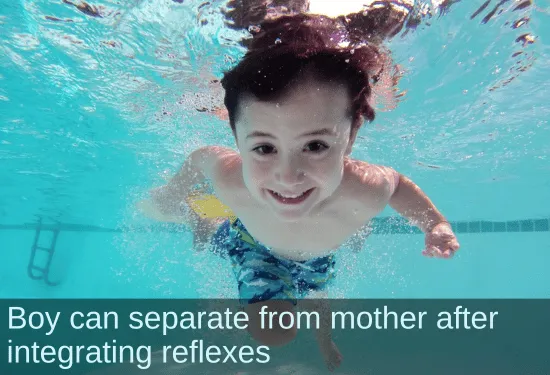Primitive Reflex Integration Case Studies
Neurodevelopmental Movements Help with Separation Anxiety
Reflex integration and rhythmic movements ease transitions and reduce tantrums
This 5-year-old boy with separation anxiety struggled with transitions and sleep. Meltdowns were long-lasting, and during swim lessons he wouldn’t put his head underwater. See how his mother used rhythmic movements and reflex integration from the Brain and Sensory Foundations, First Level course to help with all of these issues.
Submitted by Lora, parent

| Before | After |
|---|---|
| Afraid to go under the water when swimming | Now able to put his head under the water |
| Experienced separation anxiety, particularly when going to school | After 3 weeks, he is going to school more confidently |
| Challenges going to and staying asleep | Uses rhythmic movements for calm before bed |
| Occasional meltdowns that could go on for prolonged periods of time, could not be calmed | Has not had a serious tantrum since starting this program |
My son A is 5 years old. He was born extremely premature at 27 weeks. He has problems sitting still and staying focused. He has separation anxiety and has difficulty separating at school, swimming lessons and most transitions. He has occasional meltdowns that often go on for prolonged periods of time, cannot be calmed. Going to sleep and staying asleep is challenging.
GOAL: feel more confident in drop off and activities away from mom and participate in activities. Improve rest and sleep habits.
A had all primitive reflexes retained. I started with RM [rhythmic movements from the Brain and Sensory Foundations course] only, for 1 week. We went through a few options and he enjoyed RM 2b and 3 the most. After week 1 we started introducing games. We worked on the Fear Paralysis reflex before school and in the car. Eye tracking was also poor so we made up additional games with a tennis ball to keep him engaged. I chose these games because it seemed that the Moro [reflex] and Fear Paralysis were the fundamental barriers A was facing.
A is difficult to work with because of the distractibility and aversion to try unknown activities. I found the RMs very helpful to calm him before bed and during periods of hyperactivity. We let him choose which rocking he wants and do as much long as he was willing. After 3 weeks he went to school more confidently and started participating in swimming. Although there could be other factors at play I have to take notice of these changes. He has not had a serious tantrum since he started this program. When he does start to get de-regulated we use the rocking and heart connection [from the Brain and Sensory Foundations course] to diminish the episodes.
GOAL: To go to the bottom of the pool to pick up a ring. For a year he has been afraid to go under the water. I used the Fear Paralysis activities [from the Brain and Sensory Foundations course] as part of the 5-Step Balance process.
RESULT: He performed well in swimming and put his head all the way under the water. He didn’t go to the bottom of the pool on this day but he did retrieve the ring from a higher platform with confidence and got his head fully underwater. I feel this was a success.
I learned that we have to be patient, open minded, and willing to change the plan on the spot. The heart connection seemed to make a difference in the willingness to participate. The heart connection also seems to regulate my reactions to meltdowns.
I was able to work with my son 5x week. The work accumulated over the day to around 15 minutes per day over 6 weeks.
(Edited, emphasis added)
*Disclaimer: The activities in the Brain and Sensory Foundations curriculum make use of the natural processes of neuroplasticity and development that are innately wired in the design of human beings to promote maturity and function. These activities appear to calm, organize, and mature the neuro-sensory-motor systems just as we see in the healthy development of human infants. Individual results may vary, and we do not claim to offer a diagnosis or cure for any specific condition or disorder. The Brain and Sensory Foundations activities appear to improve overall functioning resulting in measurable improvements for a range of conditions as demonstrated in over 1800 case studies from participants.

